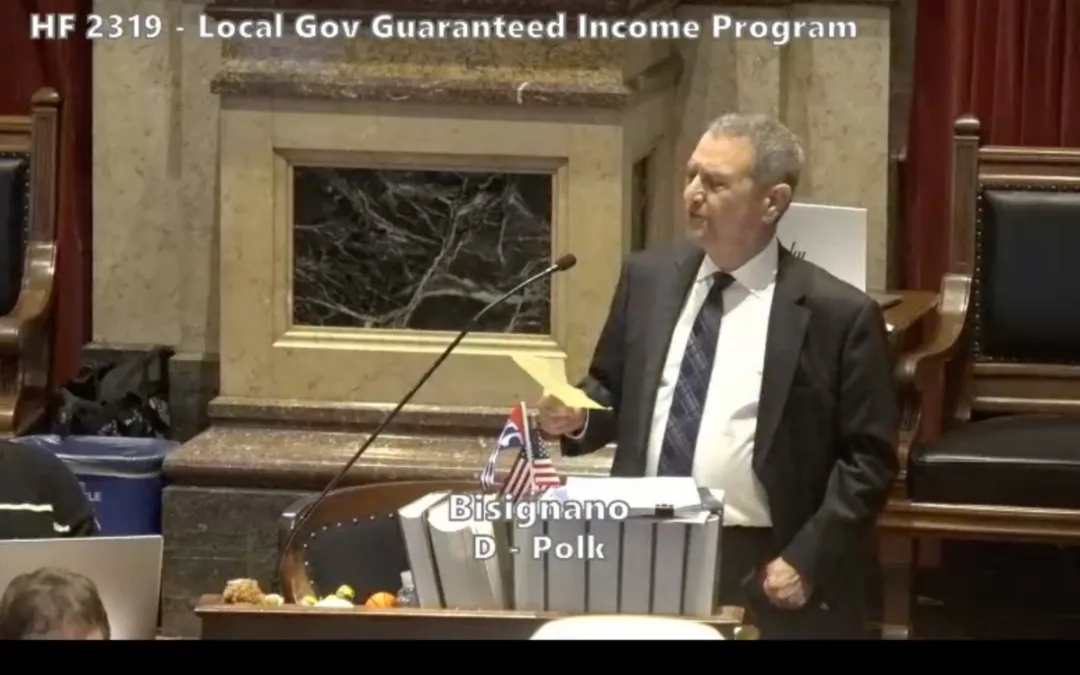
As Cedar Rapids city councilman Dale Todd took a lap around his bustling district on a recent Friday afternoon, he paused before reaching a neighborhood tavern, Parlor City, which stands adjacent to the sprawling NewBo City Market.
“This was where community members would meet to discuss how we’d rebuild the neighborhood,” said Todd. “We’re probably one of the most resilient communities in the country.”
It’s hard to imagine the area, now nearly fully developed, engulfed in flood water that devastated the city more than a decade ago. Disaster remediation tactics have gradually improved despite a lack of swift federal funding, so the community is prepared for increased flooding — their new normal.
As Iowa has experienced another year of historic flooding, the need for additional disaster control systems surfaced statewide. Climate advocates and elected officials hope the recent parade of presidential candidates will see a vast community need for more federal support.
“I think it’s pretty clear to everyone here that [flooding] is something that is a fact of life, and we have to plan and protect for it,” said Tyler Olson, an at-large Cedar Rapids city councilman. “If a community has a river nearby … If I was on the city council there, I’d sure be thinking about the risks. And reevaluating protections.”
Flooding Will Get Worse
A recent analysis by the Iowa Policy Project found the state’s flooding will worsen in coming years as the world grows warmer. University of Wisconsin-Eau Claire professor James Boulter compiled the report, which notes an uptick in extreme or heavy rainfall events in Iowa and the upper Midwest over the last decade.
A combination of increased snowfall runoff and heavy rainfall this year caused the Mississippi River to breach a levee and flood for 38 days. The Missouri River Basin also took on more runoff in three months than it typically receives in a year.
The events are said to be a repeat of the state’s most devastating “100-year floods” of 1993, 2008 and 2011. These sorts of devastating floods may become “the new normal,” Boulter said.
For the Cedar River Basin, the 100-year flood … of the 20th century is projected to be a 25-year flood in the 21st century, with associated increased frequency of flooding of agricultural land, according to a recent report by the Iowa State University Institute for Transportation.
“I think that was the most shocking statement I’d read in all of the research I’d been doing in Iowa,” Boulter said. “It was a fairly chilling conclusion to draw.”
Candidates Tour The Damage
Democratic presidential candidates saw the vast community need for increased protections and disaster relief funding firsthand as they toured some of the cities ravaged by flooding this spring.
Fran Parr, a resident of Pacific Junction, said she had an open-door policy for the candidates. Seven different Democratic hopefuls came through her home, which was nearly 9 feet deep in Missouri River flooding this summer.
“I’m getting goosebumps and chills thinking about it right now — it was like OK, they get it,” Parr said. “These are the types of leaders that you want to see succeed, that you root for.”
She endorsed Minnesota Sen. Amy Klobuchar. Among other reasons, Klobuchar’s track record in the U.S. Senate was a factor that motivated Parr’s support.
“She gets it done. She’s not ‘Dancing with the Stars’ presidential material, but she gets it done,” Parr said. “I have no qualms about the other candidates, I think they’re all very intelligent. She in particular resonated with me.”
[inline-ad id=”0″]
Disaster Comes At A Cost
Flooding in 2019 has cost the state of Iowa about $1.6 billion in damages, and that total is likely to rise in the future.
Cedar Rapids has worked since 2008 to secure funding for a permanent flood control system, according to Olson, who said the toughest part about gathering funds was the federal government.
In July 2018, the U.S. Army Corps of Engineers and the Federal Emergency Management Agency approved $117 million in flood protection funding — a decade after the 2008 floods.
It took so long because of how FEMA and the Army Corps of Engineers evaluate and prioritize requests for flood control funding, Olson said. The biggest criteria in receiving funding is the value of the property protected, which often penalizes smaller cities in rural areas.
“That’s something that I’ve talked with federal candidates about on both sides of the aisle, and hope to get fixed,” Olson said.
In the meantime, the city said the state of Iowa committed to paying 35% of the total price of a $550 million permanent flood control system. Cedar Rapids had already invested over $10 million. In March, the city raised property taxes for the first time in a decade to help cover costs.
Waterloo and Cedar Falls have also taken steps to increase protections since the flood of 2008.
Iowa City has spent nearly $100 million to raise bridges, widen roads, elevate infrastructure, transformers and capacitors, in order to try and adapt for the next flood, said Jerry Schnoor, a University of Iowa professor of civil and environmental engineering.
Mississippi River cities like Davenport, which saw its downtown inundated by floodwater this year, also are thinking more about flood control. The city on Tuesday approved the removal of two road dividers filled with dirt and plants to make way for heavier, higher flood barriers.
Not Just Adaptation, Mitigation
Flood prevention takes place in a variety of ways — some communities are building flood walls and some are using HESCO barriers, a temporary, military-grade flood defense. Others are trying to create wetlands that will better absorb floodwater, among other ways to hold water higher in the watershed.
“Everyone has an adaptation plan now. They realize it’s going to get worse,” Schnoor said. “Everyone is adapting in different ways. I’m not sure anyone knows what the smartest way is, right now.”
But, Schnoor said, the state needs to start thinking about flooding beyond just immediate protections. Rather, a focus on strategies to address the root of the worsening disasters: climate change.
“When I talk to the candidates, we’re asking for more FEMA money, but I think the message should be that we can’t go on like this — we need to mitigate as well as adapt,” Schnoor said.
By Isabella Murray
Posted 9/13/19
Politics

Biden marks Earth Day by announcing $7 billion in solar grants
The Biden administration on Monday announced the recipients of its Solar For All Program, a $7 billion climate program that aims to lower energy...

6 terrifying things that could happen if the Comstock Act is used to target abortion
Does 1873 sound like a really, really long time ago? Well, that’s because it is—but if Republicans and far-right anti-abortion activists have their...
Local News

No more Kum & Go? New owner Maverik of Utah retiring famous brand
Will Kum & Go have come and gone by next year? One new report claims that's the plan by the store's new owners. The Iowa-based convenience store...

Here’s a recap of the biggest headlines Iowa celebs made In 2023
For these famous Iowans, 2023 was a year of controversy, career highlights, and full-circle moments. Here’s how 2023 went for the following Iowans:...




